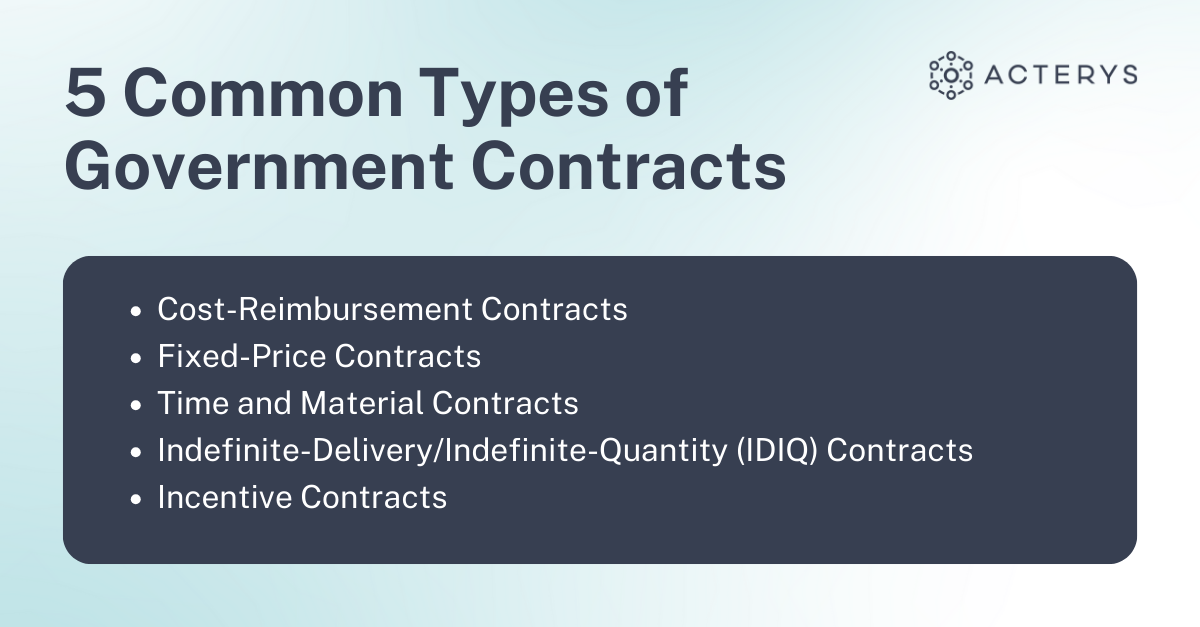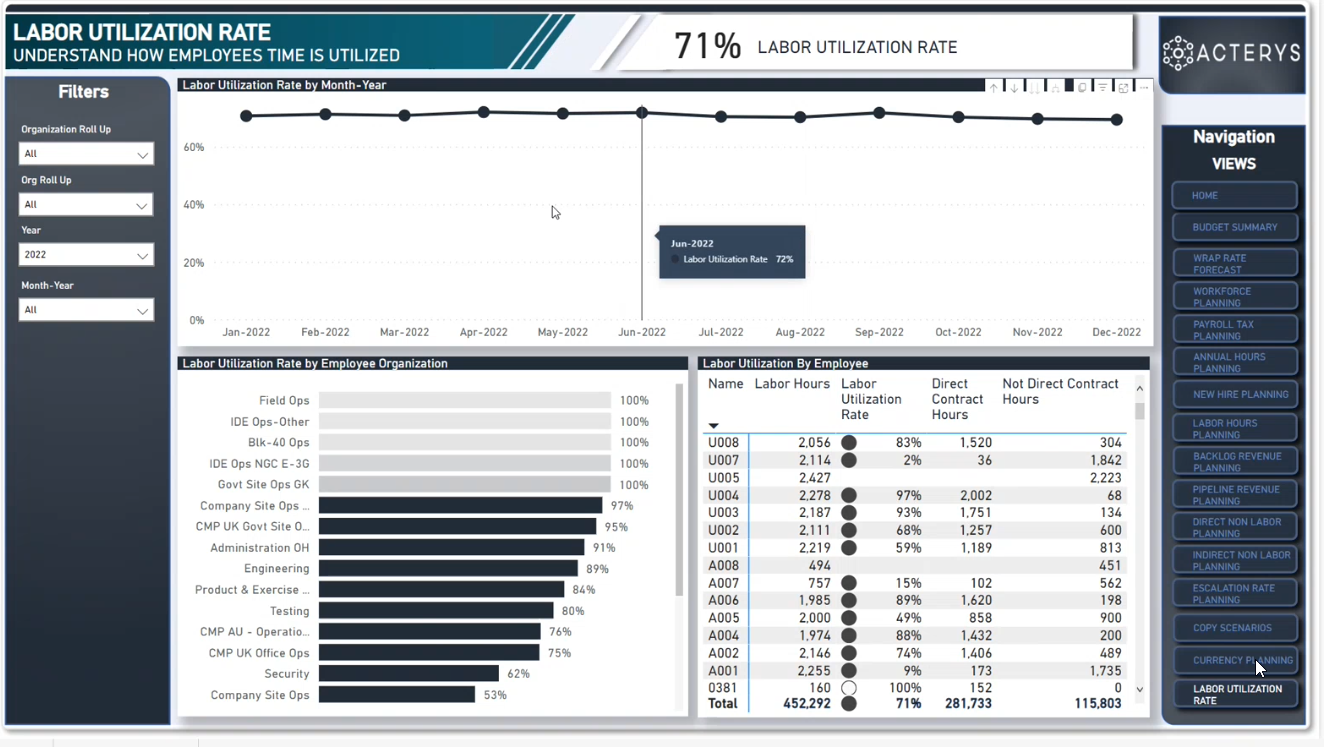
Table of Contents
Government projects are as diverse and complex as the people and communities they serve. From upgrading infrastructure to launching public health initiatives, each undertaking brings new challenges to government project management.
The good news is that there are many ways government contractors can improve their public sector project management. Read on for common challenges related to government projects, as well as practical ways to simplify projects, improve outcomes, and serve the public good.
5 Common Types of Government Contracts
Managing government projects requires understanding which type of contract you’re dealing with. Many factors affect which contract type makes sense for your business, including the products or services you’re offering. Here are five types of government contracts, each tailored to different scenarios and objectives.
Cost Reimbursement
This type of contract is best for when project details might change. Cost-reimbursement contracts cover your costs plus a bit extra for your work. This arrangement is flexible but needs monitoring to keep costs in check.
Fixed Price
When you know exactly what needs to be done and how much it’s going to cost, fixed-price contracts are the way to go. The government pays a set price, no matter your expenses. This approach offers budget certainty but requires accurate cost predictions to avoid losses.
Time and Materials
Time and materials contracts are useful when you know the project’s scope but not how much work it’ll take. These contracts pay for the time and materials used, plus a profit. They offer flexibility for project adjustments and work well with a spending cap to prevent budget overruns.
Indefinite Delivery/Indefinite Quantity
If a government entity needs your services or products repeatedly but isn’t sure when or how much, indefinite delivery/indefinite quantity (IDIQ) contracts fit the bill. The government promises to buy from you as needed, helping your business manage long-term needs without guessing about future demands.
Incentive-Based
Designed to encourage better performance, incentive-based contracts reward contractors that meet or exceed deadlines, budgets, or other metrics. They work best with clear, achievable targets that can drive efficiency and quality.

7 Challenges of Project Management in the Public Sector
Every project has its challenges, but government contracts can bring additional requirements and scrutiny. Here are common challenges encountered by contractors.
Complex Compliance Requirements
Navigating the maze of regulatory and compliance standards is a daunting task for any public sector project. Meeting government guidelines while maintaining project efficiency is only possible through meticulous planning and execution.
Some of the key compliance challenges that add to the complexity of these projects include:
- The Federal Acquisition Regulation (FAR) outlines procurement integrity requirements contractors must follow to avoid unethical behavior such as conflicts of interest and kickbacks.
- Environmental regulations, such as the Clean Air Act, Clean Water Act, and Resource Conservation and Recovery Act (RCRA), impose obligations on contractors to ensure compliance with environmental standards.
- Labor standards set forth by the Fair Labor Standards Act (FLSA) and related regulations require contractors to meet minimum wage and overtime pay requirements, as well as safety and health standards.
These are just a few examples highlighting the intricate nature of compliance requirements that government contractors must navigate to successfully execute their projects.
Budget Constraints
Public sector projects often have strict budget limits, especially for fixed-price contracts and cost-reimbursement projects with fixed caps. Effective budget forecasting and management is critical for working within these financial limitations while driving project success. These processes can be further complicated by the need to meet government expectations for cost breakdowns and labor categorization.
Budget challenges also emerge as many commonly used Deltek Costpoint systems lack dedicated budgeting modules, leaving contractors to rely on spreadsheets and disjointed data. This creates challenges in consolidating project budgets and providing a comprehensive overview to CEOs and CFOs.
Fiscal Accountability
Fiscal scrutiny is heightened in public sector projects, demanding transparency and sound financial management. Contractors must account for every dollar spent — and why it was spent — to meet contractual requirements and maintain public trust. This also means grappling with complex accounting practices, such as full absorption cost accounting and allocating indirect costs, which demands specialized knowledge and meticulous attention to detail.
Dynamic Scope and Requirements
Government projects can shift in scope and objectives for many reasons, including changing political winds, updated expectations, or unforeseen circumstances. This potential for volatility requires a flexible project management approach to adapt to changes without derailing progress.
Stakeholder Engagement and Communication
Government contractors must communicate with a variety of stakeholders, including their suppliers, any subcontractors, and government officials. In many cases, communicating with the public is also important. Keeping all parties aligned and informed can be challenging but is essential for project success.
Data Management and Reporting
Government projects can be data-intensive, with strict reporting requirements related to financial records, project progress reports, regulatory filings, and more. To deliver timely and insightful reports to stakeholders, contractors need sophisticated data analysis capabilities.
Technology Integration and Adoption
Government projects are increasingly dependent on technology, even for infrastructure projects or other initiatives that aren’t inherently digital. Technology can help contractors streamline processes, improve efficiency, track progress, generate reports, and much more. Key challenges include selecting the right tools, integrating them, and gaining buy-in and adoption from your employees.
10 Tips to Simplify Government Project Management
One of the most effective ways to simplify project management is tackling challenges related to scattered data, SaaS sprawl, and disconnected systems. This fragmentation is inefficient, contributes to organizational silos, and prevents data-driven decision-making. One way contractors can address all these challenges at once is by adopting a unified data platform.
Acterys offers a comprehensive solution that integrates every data source, along with reporting, planning, and analytics, into one platform. This simplifies government project management and improves your ability to make informed decisions based on a single source of truth.
With centralized data, government contractors can gain deeper insights into every aspect of their operations, from financials to resource allocation. With that in mind, here are 10 tips for contractors who want to simplify government project management.
Use Predictive Analytics for Forward Planning
Use predictive analytics to foresee project challenges and opportunities while quantifying the likelihood of different scenarios. For example, predictive models can assess the impact of external factors, such as changes to project costs and timelines. With these insights, you can make strategic adjustments to resource allocation.
Integrate Real-Time Financial Oversight
Real-time financial oversight and reporting allows government contractors to access the latest data, detect financial discrepancies early, and adjust budget allocations on the fly for better financial health and project viability. For example, you might create a dashboard that visualizes spending trends against project milestones, enabling you to quickly find cost overruns.
Improve Decision-Making With AI
Using artificial intelligence (AI) in public sector project management starts with data analysis, but that’s not all. AI-powered tools can simulate project outcomes based on different decision paths. For instance, you can use Microsoft Copilot with Power BI features to ask how a delayed project phase might affect overall timelines and costs. This type of scenario planning gives decision-makers a data-backed basis for accelerating tasks or reallocating resources.
Cultivate a Risk-Aware Culture
Risk management should be embedded into every level of project planning and execution. Training team members to recognize and respond to risk can prevent issues from escalating, saving time and resources in the long run. Examples of a risk-aware culture include contractors holding risk assessment workshops and deploying software that flags potential risks based on historical project data.
Optimize Resource Allocation and Personnel Utilization
Achieving project success in the public sector requires a meticulous approach to managing resources and personnel. Start by leveraging tools like Acterys to get a full view of each project’s resource utilization. With this level of transparency, project managers can confidently allocate personnel and other resources while meeting deadlines and budgets.
For example, analyzing performance insights can identify underutilized areas, creating the opportunity to redistribute resources. This quick decision-making can improve financial management and overall project delivery.

Centralize Documentation for Compliance and Efficiency
All project documentation should be centralized, both to enable easy access for employees and to make audit and compliance tasks easier. This requires consolidating existing documentation and developing a process to maintain and add relevant information. Project managers can use document management systems and other tools that integrate with project management software. With systems that talk to each other, you can make real-time updates while always viewing the latest version of project documents. If audits occur, you can show what happened and when.
Empower Teams With Collaborative Tools
Project management requires strong communication and collaboration, and technology is increasingly important for helping stakeholders work together. Look for tech platforms that make it easy for teams to share ideas, manage projects, and communicate in real time, all while keeping information secure in an innovative environment. These tools can help team members bond and build trust, knowing that they have a place to communicate and tackle problems.
Adopt Agile Project Management Practices
Agile project management methodologies can help contractors increase flexibility and adaptability when managing government projects. Agile practices center on adaptability, customer feedback, and iterative delivery.
Start by breaking down projects into smaller, manageable tasks with regular milestones for review and adaptation. Engage stakeholders often to gather feedback, then adjust your approach accordingly. Emphasize teamwork, reflection, and regular process adjustments to improve efficiency and project outcomes.
Implement Continuous Learning and Adaptation
Along with collaboration and agile project management, government contractors benefit from a culture of continuous learning. Work with HR and other leaders to develop training programs and workshops for long-term skills development. Additionally, project debriefs allow employees to reflect on what happened, learn from project data, and apply these learnings to future tasks and projects.
Streamline Reporting With Custom Dashboards
Custom dashboards should do more than generate visualizations of key performance indicators; they should empower users to drill down for detailed analysis, what-if scenarios, and much more. For instance, a project management dashboard could show overall project health at a glance while enabling managers to access detailed reporting on individual tasks or budget items.

Use Tools Built for Government Contractors
Simplifying government project management requires having the right tools, technology, and people. The right tools empower your team to get work done, communicate and collaborate, and surface ideas that make projects more effective and innovative.
To ensure your project management approach is effective and current, look for tools specifically designed for government contractors and built to work with existing platforms like Deltek Costpoint, Power BI, and Excel. Acterys offers a comprehensive solution that simplifies financial planning, reporting, and analytics while empowering contractors to customize data models, apply AI capabilities, and choose applications that best suit your project needs.
With Acterys, you can solve accounting problems by moving away from error-prone spreadsheets and collating data, and instead have a self-sustaining database for inputting and calculating forecasts and figures. Acterys also provides the ability to cascade down indirect costs to the project level, similar to Costpoint, but without the high cost and complexity associated with it. This allows government contractors to accurately estimate costs, rates, and budgets, ensuring they can bid competitively and avoid potential audit issues.
Ready to see how Acterys can help streamline your compliance, budgeting, cost planning, forecasting, and project-tracking processes? Start your free trial now.




